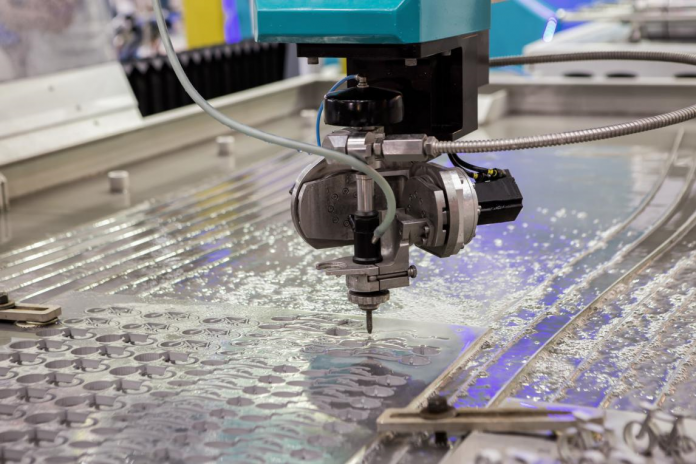Did you know that virtually any material can be cut with water?
Well, not just any water.
Water jets harness the power of pressure and abrasives in order to make clean cuts with low tolerances.
If you’re interested in how these fascinating tools work, then you’re in the right place. Read on and we’ll discuss the machining process which makes water jets an excellent option for many applications.
How Do Water Jets Work?
While it seems impossible to some, water jets actually have the ability to cut virtually any material.
Through the miracle of extremely high pressures. Water is then pumped through a tiny nozzle, increasing the pressure to levels that make a pressure washer look like your garden hose.
They can reach pressures in excess of 50,000 PSI. The nozzle is a bit different than what most people think of: the final orifice is actually a tiny hole in a jewel.
Without the use of abrasives, water jets are able to cut many materials easily. This includes wood, rubber, and plastics. Due to the tiny kerf, or amount of material removed, these parts can be made with extreme precision.
Most people are interested in how water can harder materials, however, especially since they can easily cut materials that processes like plasma or laser cutting can’t even touch.
They do so through the introduction of an abrasive material into the stream of water.
This creates an action similar to sanding, but in a tight area and with a lot more speed than you’d be able to get with sandpaper. Virtually everything has seen usage for water jet cutting at one point or another, from silicon oxide to diamond, but the primary abrasive used is almandine garnet.
The operator has to take into account the shape, size, and other factors of the abrasive to make the cleanest cut.
With such a tiny kerf, however, early water jets quickly outstripped the capabilities of their human operators.
Enter Computers: CnC for Water Jets
Water jet cutting with modern machines is most often done through a CnC process. These computer controls allow for tighter control than even the best human with the push of a button.
CnC controls receive an intricate schematic, usually, through a CAD program, which allows for cuts made with the precision water jets are known for.
In the early days water jets were also limited to 2-dimensional cuts. This greatly limited their use despite the precision and clean finish.
Fortunately, computer-aided waterjets have now reached a point where the CnC controls can precisely cut into the material at angles and create 3-dimensional objects which don’t require a lot of finishing work.
With computer-aided controls, the process is pretty much unstoppable. Water jets are seeing increasing use in industries where tight tolerance and low material removal are essential such as aviation and medical parts.
What Advantages Do Water Jets Offer?
The biggest advantage of water jets comes easily: with the right abrasive a waterjet allows for cutting of any material which can be used.
Stone, for instance, can’t be cut at all with most of the traditional machining processes available.
They can also cut specialty metals and alloys like titanium which makes them valuable for precision parts.
In addition to the range of materials cut, they’re also able to cut through thicker materials than is possible with a laser or plasma cutter. Combined with CnC processes this creates the ability to manufacture parts that would require multiple machines with a single process.
Water jet cutting produces no deformation of the surface and often renders the workpiece quite smooth. That means less finishing on other machines like mills and lathes once the piece has been cut, saving time and money for the operators.
They’re also remarkably green. They cut using water and a virtually inert abrasive. There’s no waste of energy or toxic waste produced, not even the small amounts of slag which come from heated cutting processes.
Overall, they’re a fantastic way to form both artistic components and precision parts.
Are There Disadvantages?
Like any machining process, water jets aren’t perfect.
The main disadvantage of running a water jet comes with the cost. While the energy input isn’t excessive, the parts wear down quickly due to the extreme pressures and abrasives involved in the process.
The nozzle generally only has a lifespan of 40 to 80 hours of run time for instance. After that, it will need to be replaced, since there will be degradation of cutting quality.
They also cut more slowly than most other processes. While it may not matter for a rapid prototype it limits their capabilities for mass production of complex parts, it can hurt the profits for the owner of the shop where one is used.
The limited lifespan of the parts can also hurt the bottom end as things need to be continuously replaced and the parts need to be on hand constantly to keep the water jet running.
The accuracy of the cut can change in thicker materials as well. While this can be mitigated to some extent the ability to cut through especially large stock is limited when compared to milling or lathing since the water isn’t as accurate once it gets farther from the jet.
Knowing Water Jets
Water jets are fascinating and their unparalleled advantages outweigh the minor adversity they face in costs.They’re complex and fascinating devices and the more one learns about them the more fantastic they seem.
The best part? If you’re interested there are many companies available who are experts in the process. Why not try one the next time you need a part produced?
Don’t forget to bookmark our site to never miss our latest posts!

